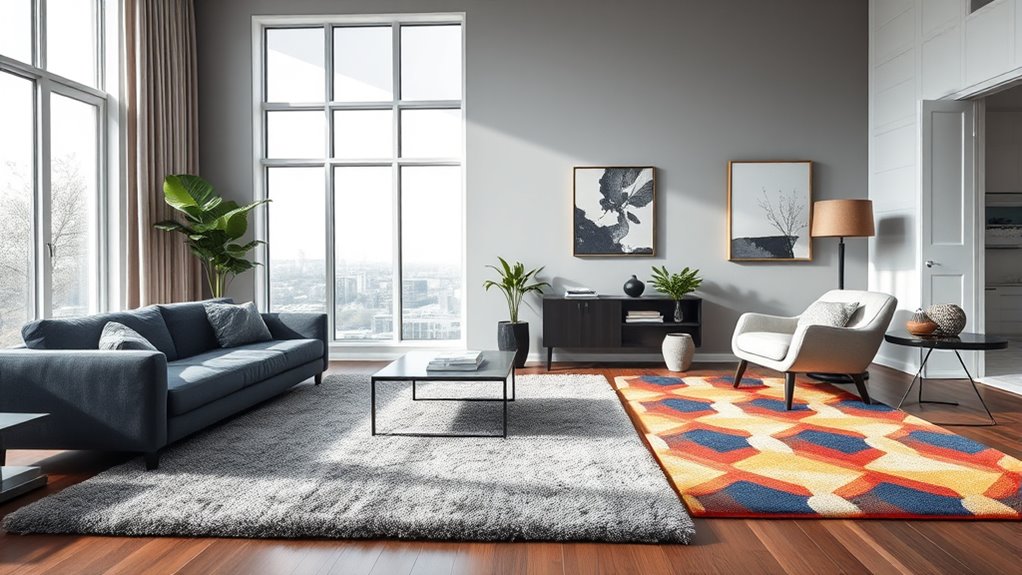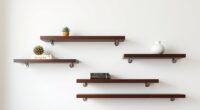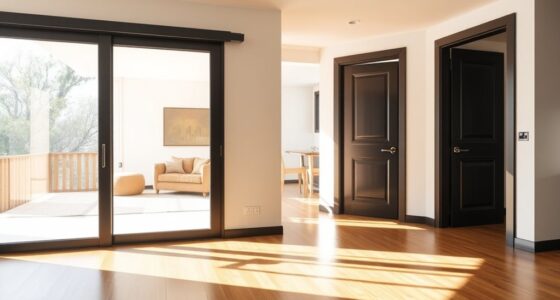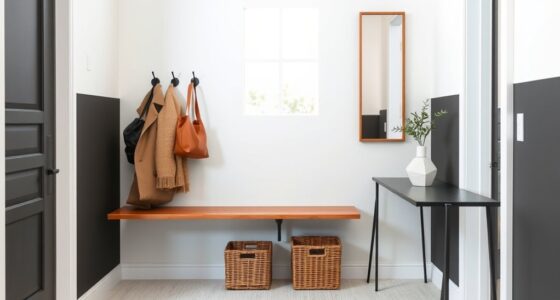Using rugs for room function zoning helps you create distinct areas in open-plan spaces without building walls. By selecting different rugs or placing a large rug under furniture, you visually separate zones like the living room or dining area. Rugs also guide movement and add style, making your space more functional and inviting. Want to discover smart tips to maximize this technique? Keep exploring to learn even more.
Key Takeaways
- Rugs create visual boundaries that segment open spaces into distinct functional zones without physical walls.
- Different rugs under furniture or in areas help define specific functions like dining, lounging, or working.
- Pattern, color, and texture of rugs add visual interest and reinforce the separation of different zones.
- Using rugs for zoning improves space organization, flow, and accessibility in open-plan layouts.
- Rugs are a flexible, cost-effective way to personalize and adapt room functions over time.

Have you ever wondered how to make your living space both functional and inviting? One simple yet effective way is through room function zoning, especially by using rugs to create distinct areas. You don’t need walls or partitions to define different zones; instead, strategic placement of rugs can serve as a tool for area separation and visual segmentation. This technique helps you organize your space without sacrificing openness or flow, making your home feel more tailored to your lifestyle.
When you choose the right rug for each zone, you’re fundamentally drawing a visual line that separates one area from another. For instance, placing a large, plush rug under your sofa and coffee table instantly sets apart the living area from the dining space. The rug acts as a visual cue, signaling that this section is meant for relaxation and socializing. Meanwhile, a different rug under the dining table creates a clear boundary, helping to organize the flow of movement and activity within the room. This use of visual segmentation ensures that each space serves its purpose without the need for physical barriers.
Additionally, understanding the importance of visual segmentation can help you craft a more harmonious environment that caters to your daily routines and aesthetic preferences. Area separation with rugs is not just about aesthetics; it’s about functionality too. By defining zones with different rugs, you can create designated spots for various activities—reading, working, dining, or lounging. This makes your space more efficient and comfortable, especially in open-plan layouts. Imagine having a cozy corner with a small, textured rug for reading, separate from a sleek, low-pile rug in your workspace. These visual distinctions help you, and anyone else in your home, intuitively understand how to navigate the space and what each area is meant for.
Furthermore, rugs allow you to experiment with different styles, colors, and textures to enhance the visual segmentation. A patterned rug can add energy to a subdued room, while a neutral, solid-colored rug can create a calming influence. When you layer rugs or use contrasting textures, you deepen the sense of separation and add visual interest. This flexibility means you can easily update or change zones as your needs evolve, without major renovations.
In short, using rugs for room function zoning is a clever and adaptable solution. It offers a way to organize your space through visual segmentation and area separation, making your home not only more functional but also more inviting. With just a few well-chosen rugs, you can transform an open floor plan into a series of purposeful, comfortable zones that reflect your personal style.
Frequently Asked Questions
Can Rugs Be Used to Divide Outdoor Living Areas?
Yes, you can use rugs to divide outdoor living areas. Choose outdoor rugs made from weather-resistant materials that can withstand sun, rain, and foot traffic. These rugs help define different zones, like a dining space or lounging area, without walls. Make sure to select durable options designed for outdoor use, so your space remains stylish and functional over time. Rugs instantly create a cozy, organized outdoor environment.
What Materials Are Best for High-Traffic Zone Rugs?
They say “a stitch in time saves nine,” and that applies here. For high-traffic zones, you should choose durable materials like polypropylene, nylon, or outdoor rugs made from polypropylene or acrylic. These materials offer excellent durability considerations and are easy to clean, making maintenance tips simple. Opt for low-pile or flat-weave designs to withstand wear and tear, ensuring your rug stays beautiful and functional over time.
How Do Color Choices Affect Space Perception With Rugs?
Color choices substantially impact how you perceive a space with rugs. Using color psychology, light or neutral shades can make a room feel larger and more open, creating a sense of visual expansion. Darker or bold colors tend to anchor the space, making it feel cozier but smaller. When selecting a rug, consider these effects to enhance or define your room’s atmosphere, making it feel spacious or intimate as desired.
Are There Safety Concerns With Large Area Rugs?
You should consider safety concerns with large area rugs, as they can pose slip hazards, especially on smooth floors. To prevent falls, use non-slip rug pads and ensure edges are secured. Also, think about fire safety—avoid rugs near heat sources or with synthetic fibers that can catch fire easily. Taking these precautions keeps your space both stylish and safe for everyone.
How Can Rugs Be Layered for Functional Zoning?
Imagine transforming your space with a single move—rug layering! You can effortlessly create visual depth and define zones by overlapping different sizes, textures, and patterns. Use a large base rug and layer smaller ones on top, positioning them to highlight specific areas like seating or reading nooks. This technique not only adds style but also clarifies function, making your room feel organized and inviting without adding any walls.
Conclusion
Think of rugs as the silent artists of your space, painting boundaries without a single wall in sight. They carve out cozy corners, energize open plans, and whisper your home’s story with every pattern and texture. With just a few well-placed rugs, you turn an empty room into a vibrant tapestry of purpose and personality. So, let your floors do the talking—creating a harmonious dance of function and style beneath your feet.









